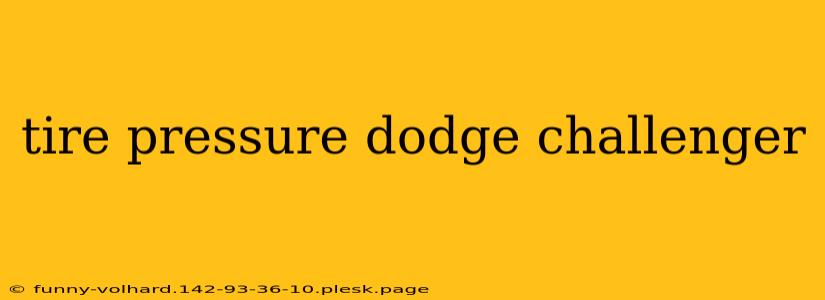Maintaining the correct tire pressure in your Dodge Challenger is crucial for safety, performance, and fuel efficiency. Underinflation or overinflation can lead to a range of problems, from reduced handling and increased wear to potential tire failure. This guide will walk you through understanding your Challenger's tire pressure requirements and how to properly check and adjust them.
Finding Your Dodge Challenger's Recommended Tire Pressure
The most reliable source for your Dodge Challenger's recommended tire pressure is the sticker located on the driver's side doorjamb. This sticker provides the recommended tire pressure for both the front and rear tires, often specifying different pressures depending on whether the vehicle is loaded or unloaded. Pay close attention to this sticker; it's the manufacturer's specification and should be your primary guide.
Don't rely solely on the information printed on the tire sidewall. While the sidewall indicates the maximum pressure the tire can handle, it doesn't reflect the optimal pressure for your specific vehicle and driving conditions. The doorjamb sticker takes into account your Challenger's weight and suspension.
Understanding the Tire Pressure Numbers
The numbers on the doorjamb sticker will usually be expressed in PSI (pounds per square inch). You'll see separate figures for the front tires and the rear tires. For example, you might see "32 PSI Front" and "35 PSI Rear." Sometimes, a higher pressure might be recommended for a fully loaded vehicle. Always check the sticker carefully to understand the relevant figures for your situation.
Checking Your Tire Pressure
Checking your tire pressure is a straightforward process best performed when the tires are cold. "Cold" means the tires haven't been driven on for at least three hours or haven't been driven more than a mile or two. Driving on the tires heats them up, increasing the pressure reading. A hot tire reading will be inaccurate.
Here's how to check your tire pressure:
- Gather your tools: You'll need a reliable tire pressure gauge. Digital gauges are generally more accurate than analog ones.
- Locate the valve stem: This is the small metal stem protruding from each tire.
- Attach the gauge: Press the gauge firmly onto the valve stem. You should hear a hiss of air as the gauge reads the pressure.
- Read the pressure: Note the pressure displayed on the gauge.
- Compare to the recommended pressure: Check your doorjamb sticker to see if the pressure matches the recommended PSI.
- Repeat for all tires: Check each tire individually.
Adjusting Your Tire Pressure
If your tire pressure is below the recommended level, you'll need to add air using a compressor or air pump found at most gas stations. If the pressure is too high, you'll need to release some air using the valve stem. Never use a sharp object to release air, as this could damage the valve stem.
Remember to check the pressure regularly, ideally once a month or before long trips. Consistent monitoring ensures optimal tire performance and safety for your Dodge Challenger.
Impact of Incorrect Tire Pressure
Driving with incorrect tire pressure can have several negative consequences:
- Reduced Fuel Efficiency: Underinflated tires increase rolling resistance, leading to lower gas mileage.
- Uneven Tire Wear: Incorrect pressure can cause uneven wear, shortening the lifespan of your tires.
- Compromised Handling: Underinflated or overinflated tires can affect your vehicle's handling and stability, making it more difficult to control.
- Increased Risk of Blowouts: Severely underinflated tires are significantly more prone to failure.
By following these simple steps and paying attention to your Dodge Challenger's tire pressure, you can enhance your safety, improve fuel economy, and extend the life of your tires. Remember, proper tire maintenance is an essential aspect of responsible vehicle ownership.

